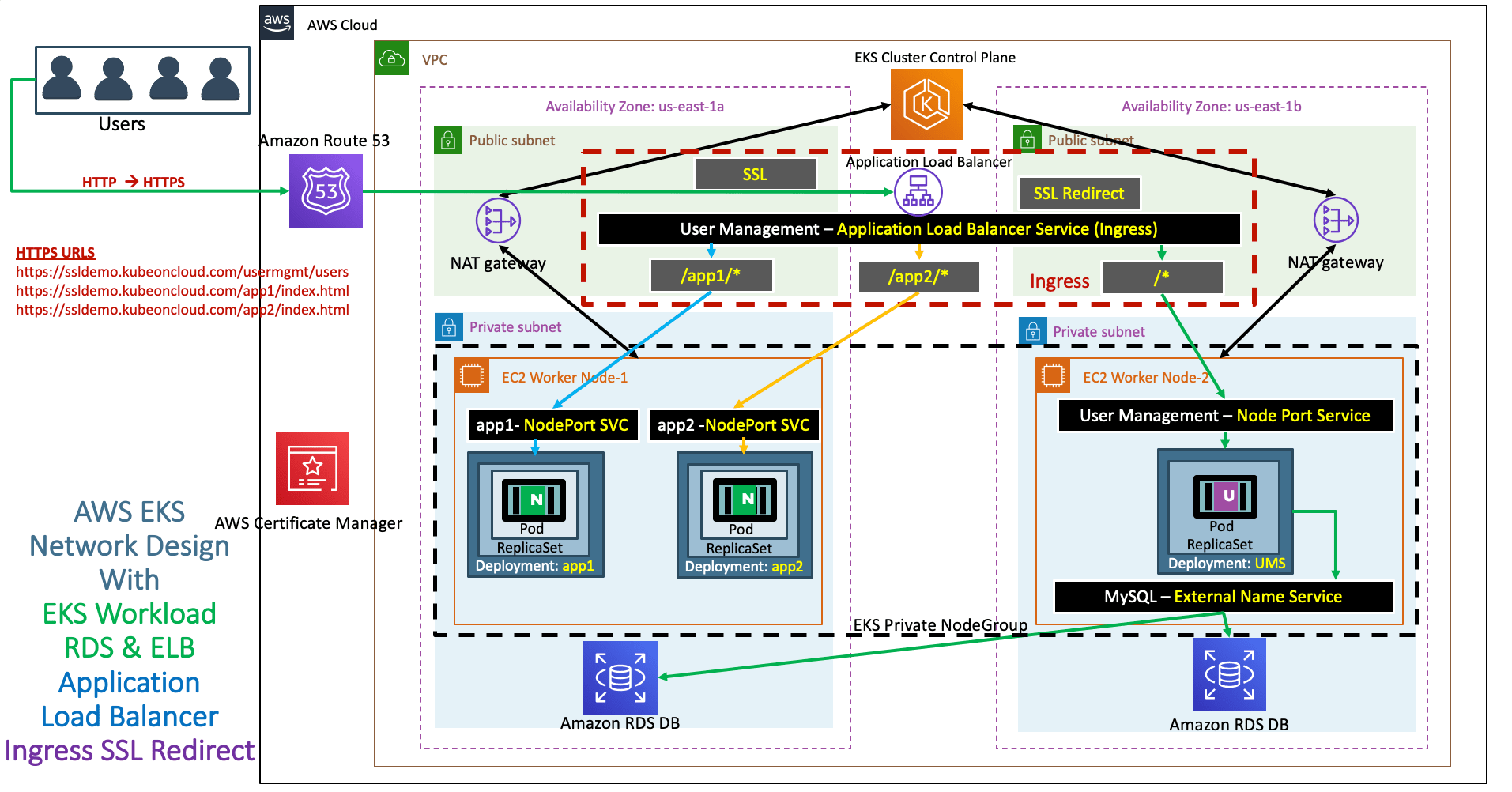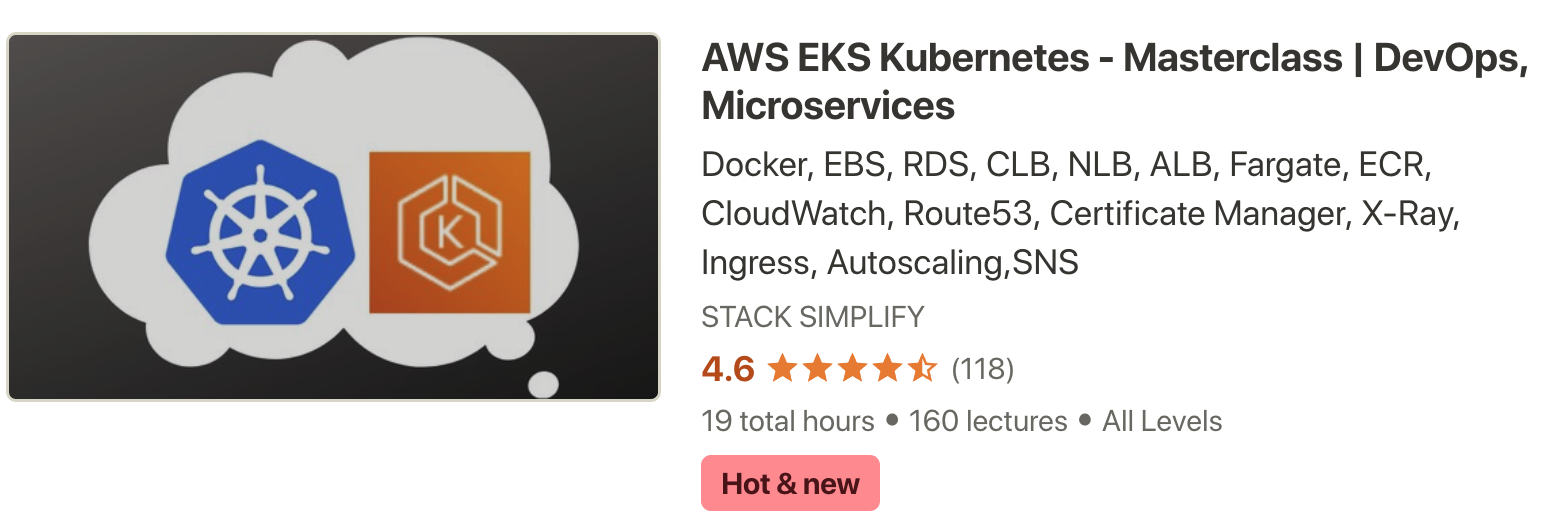AWS ALB Ingress Controller - Implement HTTP to HTTPS Redirect ¶
Step-01: Add annotations related to SSL Redirect ¶
- Redirect from HTTP to HTTPS
- Provides a method for configuring custom actions on a listener, such as for Redirect Actions.
- The
action-namein the annotation must match theserviceNamein the ingress rules, andservicePortmust beuse-annotation. - Reference for Custom Actions: https://kubernetes-sigs.github.io/aws-alb-ingress-controller/guide/ingress/annotation/#actions
Kubernetes Manifests ¶
#01-MySQL-externalName-Service.yml
apiVersion: v1
kind: Service
metadata:
name: mysql
spec:
type: ExternalName
externalName: usermgmtdb.cxojydmxwly6.us-east-1.rds.amazonaws.com
#02-UserManagementMicroservice-Deployment-Service.yml
apiVersion: apps/v1
kind: Deployment
metadata:
name: usermgmt-microservice
labels:
app: usermgmt-restapp
spec:
replicas: 1
selector:
matchLabels:
app: usermgmt-restapp
template:
metadata:
labels:
app: usermgmt-restapp
spec:
initContainers:
- name: init-db
image: busybox:1.31
command: ['sh', '-c', 'echo -e "Checking for the availability of MySQL Server deployment"; while ! nc -z mysql 3306; do sleep 1; printf "-"; done; echo -e " >> MySQL DB Server has started";']
containers:
- name: usermgmt-restapp
image: stacksimplify/kube-usermanagement-microservice:1.0.0
ports:
- containerPort: 8095
env:
- name: DB_HOSTNAME
value: "mysql"
- name: DB_PORT
value: "3306"
- name: DB_NAME
value: "usermgmt"
- name: DB_USERNAME
value: "dbadmin" # RDS DB Username is dbadmin
- name: DB_PASSWORD
valueFrom:
secretKeyRef:
name: mysql-db-password
key: db-password
livenessProbe:
exec:
command:
- /bin/sh
- -c
- nc -z localhost 8095
initialDelaySeconds: 60
periodSeconds: 10
readinessProbe:
httpGet:
path: /usermgmt/health-status
port: 8095
initialDelaySeconds: 60
periodSeconds: 10
#03-Kubernetes-Secrets.yml
apiVersion: v1
kind: Secret
metadata:
name: mysql-db-password
type: Opaque
data:
db-password: ZGJwYXNzd29yZDEx
#04-UserManagement-NodePort-Service.yml
apiVersion: v1
kind: Service
metadata:
name: usermgmt-restapp-nodeport-service
labels:
app: usermgmt-restapp
annotations:
#Important Note: Need to add health check path annotations in service level if we are planning to use multiple targets in a load balancer
alb.ingress.kubernetes.io/healthcheck-path: /usermgmt/health-status
spec:
type: NodePort
selector:
app: usermgmt-restapp
ports:
- port: 8095
targetPort: 8095
#05-Nginx-App1-Deployment-and-NodePortService.yml
apiVersion: apps/v1
kind: Deployment
metadata:
name: app1-nginx-deployment
labels:
app: app1-nginx
spec:
replicas: 1
selector:
matchLabels:
app: app1-nginx
template:
metadata:
labels:
app: app1-nginx
spec:
containers:
- name: app1-nginx
image: stacksimplify/kube-nginxapp1:1.0.0
ports:
- containerPort: 80
---
apiVersion: v1
kind: Service
metadata:
name: app1-nginx-nodeport-service
labels:
app: app1-nginx
annotations:
#Important Note: Need to add health check path annotations in service level if we are planning to use multiple targets in a load balancer
alb.ingress.kubernetes.io/healthcheck-path: /app1/index.html
spec:
type: NodePort
selector:
app: app1-nginx
ports:
- port: 80
targetPort: 80
#06-Nginx-App2-Deployment-and-NodePortService.yml
apiVersion: apps/v1
kind: Deployment
metadata:
name: app2-nginx-deployment
labels:
app: app2-nginx
spec:
replicas: 1
selector:
matchLabels:
app: app2-nginx
template:
metadata:
labels:
app: app2-nginx
spec:
containers:
- name: app2-nginx
image: stacksimplify/kube-nginxapp2:1.0.0
ports:
- containerPort: 80
---
apiVersion: v1
kind: Service
metadata:
name: app2-nginx-nodeport-service
labels:
app: app2-nginx
annotations:
#Important Note: Need to add health check path annotations in service level if we are planning to use multiple targets in a load balancer
alb.ingress.kubernetes.io/healthcheck-path: /app2/index.html
spec:
type: NodePort
selector:
app: app2-nginx
ports:
- port: 80
targetPort: 80
#07-ALB-Ingress-SSL-Redirect.yml
# Annotations Reference: https://kubernetes-sigs.github.io/aws-alb-ingress-controller/guide/ingress/annotation/
apiVersion: extensions/v1beta1
kind: Ingress
metadata:
name: ingress-usermgmt-restapp-service
labels:
app: usermgmt-restapp
annotations:
# Ingress Core Settings
kubernetes.io/ingress.class: "alb"
alb.ingress.kubernetes.io/scheme: internet-facing
# Health Check Settings
alb.ingress.kubernetes.io/healthcheck-protocol: HTTP
alb.ingress.kubernetes.io/healthcheck-port: traffic-port
#Important Note: Need to add health check path annotations in service level if we are planning to use multiple targets in a load balancer
#alb.ingress.kubernetes.io/healthcheck-path: /usermgmt/health-status
alb.ingress.kubernetes.io/healthcheck-interval-seconds: '15'
alb.ingress.kubernetes.io/healthcheck-timeout-seconds: '5'
alb.ingress.kubernetes.io/success-codes: '200'
alb.ingress.kubernetes.io/healthy-threshold-count: '2'
alb.ingress.kubernetes.io/unhealthy-threshold-count: '2'
## SSL Settings
alb.ingress.kubernetes.io/listen-ports: '[{"HTTPS":443}, {"HTTP":80}]'
alb.ingress.kubernetes.io/certificate-arn: arn:aws:acm:us-east-1:180789647333:certificate/9f042b5d-86fd-4fad-96d0-c81c5abc71e1
#alb.ingress.kubernetes.io/ssl-policy: ELBSecurityPolicy-TLS-1-1-2017-01 #Optional (Picks default if not used)
# SSL Redirect Setting
alb.ingress.kubernetes.io/actions.ssl-redirect: '{"Type": "redirect", "RedirectConfig": { "Protocol": "HTTPS", "Port": "443", "StatusCode": "HTTP_301"}}'
spec:
rules:
#- host: ssldemo.kubeoncloud.com # SSL Setting (Optional only if we are not using certificate-arn annotation)
- http:
paths:
- path: /* # SSL Redirect Setting
backend:
serviceName: ssl-redirect
servicePort: use-annotation
- path: /app1/*
backend:
serviceName: app1-nginx-nodeport-service
servicePort: 80
- path: /app2/*
backend:
serviceName: app2-nginx-nodeport-service
servicePort: 80
- path: /*
backend:
serviceName: usermgmt-restapp-nodeport-service
servicePort: 8095
# Important Note-1: In path based routing order is very important, if we are going to use "/*", try to use it at the end of all rules.
Change-1: Add the Custom Action Annotation ¶
# SSL Redirect Setting
alb.ingress.kubernetes.io/actions.ssl-redirect: '{"Type": "redirect", "RedirectConfig": { "Protocol": "HTTPS", "Port": "443", "StatusCode": "HTTP_301"}}'
{
"Type":"redirect",
"RedirectConfig":{
"Protocol":"HTTPS",
"Port":"443",
"StatusCode":"HTTP_301"
}
Change-2: Add the following Path as first ingress rule in the Rules section ¶
- path: /* # SSL Redirect Setting
backend:
serviceName: ssl-redirect
servicePort: use-annotation
Step-02: Deploy all manifests and test ¶
- Deploy
# Deploy kubectl apply -f kube-manifests/ - Verify
- Load Balancer - Listeneres (Verify both 80 & 443)
- Load Balancer - Rules (Verify both 80 & 443 listeners)
- Target Groups - Group Details (Verify Health check path)
- Target Groups - Targets (Verify all 3 targets are healthy)
- Verify ingress controller from kubectl
kubectl get ingress
Step-04: Access Application using newly registered DNS Name ¶
- Access Application
# HTTP URLs (Should Redirect to HTTPS) http://ssldemo.kubeoncloud.com/app1/index.html http://ssldemo.kubeoncloud.com/app2/index.html http://ssldemo.kubeoncloud.com/usermgmt/health-status # HTTPS URLs https://ssldemo.kubeoncloud.com/app1/index.html https://ssldemo.kubeoncloud.com/app2/index.html https://ssldemo.kubeoncloud.com/usermgmt/health-status
AWS EKS - Elastic Kubernetes Service - Masterclass ¶
Step-05: Clean Up ¶
Delete Manifests ¶
kubectl delete -f kube-manifests/
Delete Route53 Record Set ¶
- Delete Route53 Record we created (ssldemo.kubeoncloud.com)
Step-06: Annotation Reference ¶
- Discuss about location where that Annotation can be placed (Ingress or Service)
- https://kubernetes-sigs.github.io/aws-alb-ingress-controller/guide/ingress/annotation/

